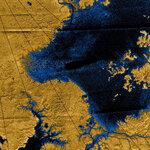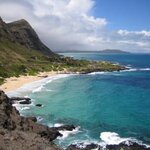Geology

The earthquake that shook Sumatra on on April 11, 2012 is distinct, not just because it was magnitude-8.6 but also because it was both larger than scientists thought an earthquake of its type could ever be and it was rupturing along multiple faults that lie at nearly right angles to one another.
Like an underwater earthquake in a maze.
Most mega-earthquakes occur at the boundaries between tectonic plates, as one plate sinks beneath another. The 2012 Sumatra earthquake is the largest earthquake ever documented that occurred away from such a boundary—a so-called intraplate…

Compared to most moons in our solar system, Titan is relatively smooth. It has few craters but Titan is around four billion years old, about the same age as the rest of the solar system - so it isn't an age issue. Yet if you went by the number of craters, its surface looks much younger, between 100 million and one billion years old.
In 2004, radar images from the Cassini-Huygens spacecraft penetrated the atmosphere of Titan and revealed an icy terrain carved out over millions of years by rivers of liquid methane, similar to how rivers of water have etched into Earth's rocky continents…

A new study says a portion of the groundwater in the upper Patapsco aquifer underlying Maryland is truly ancient- over a million years old.
The work from the US Geological Survey, the Maryland Geological Survey (MGS) and the Maryland Department of the Environment (MDE) documents for the first time the occurrence of groundwater that is more than one million years old in a major water-supply aquifer along the Atlantic Coast. The oldest groundwater was found in the deepest parts of the aquifer, but groundwater even in shallower parts of the aquifer is tens to hundreds of thousands years…

Space is an extremely hostile environment. You knew that, though no one wants to think about exploding instantly as their blood boils without an atmosphere (or it does not - like how airplanes fly, this seems to still be a debate). Most planets aren't all that much better. Yet man is going out there at some point and when that happens, we need to have a plan for growing things and recycling. During long duration missions it is not economical or practical to resupply basic life support elements from Earth.
The MELiSSA (Micro-Ecological Life Support System Alternative) project is (or…

Molecules containing large chains of carbon and hydrogen, which happen to be the building blocks of all life on Earth, have been found in meteorites from Mars but scientists have been unsure how this organic carbon was formed and even disagreed on whether or not it came from Mars.
A new paper shows evidence that this carbon did originate on Mars - but don't call the folks at SETI just yet, it isn't biological. Theories about the origin of the large carbon macromolecules detected in Martian meteorites include contamination from Earth or other meteorites, the results of chemical…

Based on new fossil evidence, the age of the Rhine river is five million years older than previously believed.
The famous Rhine of song and legend flows through Switzerland, Austria, Germany and the Netherlands on its way to the North Sea. The catchment area of the Rhine, around 1,200 kilometers of it, draws from Luxembourg, Belgium, France, Lichtenstein and Italy. As widely known as the river is, its original age has remained a science puzzle.
The consensus has been that the Proto-Rhine is around ten million years old, explains Prof. Madelaine Böhme, leading author of a new…

Over the past century, 70 percent of beaches on the islands of Kaua'i, O'ahu, and Maui have had long-term erosion, according to a U.S. Geological Survey (USGS) and University of Hawai'i (UH) report released today.
They studied more than 150 miles of island coastline (essentially every beach) and found the average rate of coastal change – taking into account beaches that are both eroding and accreting – was 0.4 feet of erosion per year from the early 1900s to 2000s. Of those beaches eroding, the most extreme case was nearly 6 feet per year near Kualoa Point, East O'ahu.
Of the three islands,…

The "plumbing systems" that lie under volcanoes, the location and behavior of magma chambers on the Earth's mid-ocean ridge system, a vast chain of volcanoes along which the Earth forms new crust, could bring scientists closer to predicting large eruptions. Researchers worked in Afar (Ethiopia) and Iceland, the only places where mid-ocean ridges appear above sea level. Volcanic ridges (or "spreading centers") occur when tectonic plates rift or pull apart. Magma injects itself into weaknesses in the brittle upper crust, erupting as lava and forming new crust upon cooling. …

A chemical analysis of lunar soil collected by Apollo astronauts forty years disputes the belief that a giant collision between Earth and a Mars-sized object gave birth to the moon 4.5 billion years ago.
In the giant-collision scenario, computer simulations suggest that the moon had two parents: Earth and a hypothetical planetary body called “Theia” but a comparative analysis of titanium from the moon, Earth and meteorites indicates the moon’s material came from Earth alone.
If two objects had given rise to the moon, “Just like in humans, the moon would have inherited some of the material…

ESA’s GOCE gravity satellite has provided us with the first high-resolution map of the boundary between Earth’s crust and mantle – the Mohorovičić discontinuity, or Moho.
Earth’s crust, as you know, is the outermost solid shell of our planet. Even though it makes up less than 1% of the volume of the planet, the crust is exceptionally important not just because we live on it, but because is the place where all our geological resources like natural gas, oil and minerals come from. The crust and upper mantle is also the place where most geological processes of great importance occur, such as…